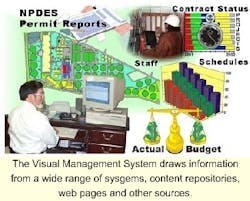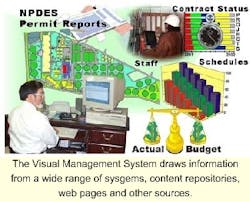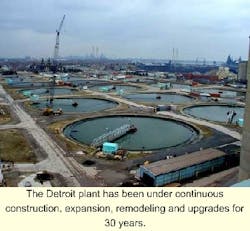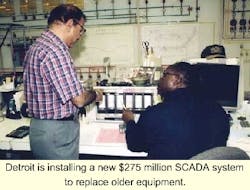"Visual Management System" to Help Detroit Manage Wastewater Department
James Laughlin- Editor, WaterWorld
The Detroit Water and Sewerage Department and Westin Engineering are developing a web-based Utility Information Management System for the department's Wastewater Operations Group. The electronic Visual Management System (eVMS) will give managers a real-time, birds-eye-view of their facility and highlight impending compliance issues.
The eVMS is designed to provide managers with information they need to make decisions about the operation of the wastewater system. It integrates data from all of the department's information technology applications and SCADA systems. Users can navigate around the system using a standard "point and click" graphical interface familiar to anyone who uses the Internet.
"We think it is going to revolutionize the way the water industry looks at their data, and the way they access information," said Westin's Chief Operating Officer, Libby Alumbaugh. "The system aggregates content from around an enterprise. It looks at disparate data elements and systems and pulls them together into a very simple and easy to use application."
The system is being developed to help the Detroit Water & Sewerage Department (DWSD) comply with a Federal consent judgment and manage the complex department, said Gary Fujita, Assistant Director of Detroit's Waste and Water Operations Group.
The eVMS "Will help us develop a master schedule to keep track of projects being planned or under construction and stay in compliance while equipment goes in and out of service," Fujita said. "It will help us find pinch points or conflicts that could inadvertently shut the plant down."
DWSD is among the largest water/wastewater agencies in the nation. Its single wastewater treatment plant has an average flow of 750 mgd and a capacity of 1.7 billion gallons a day. The plant has been under continuous construction, expansion, remodeling and upgrades for 30 years.
Despite the on-going work, between August 1997 and March 1999 a number of major pieces of equipment at the plant failed at once. The equipment failures, caused by insufficient capital expenditures and poorly communicated maintenance activities, resulted in DWSD reporting National Pollutant Discharge Elimination System (NPDES) permit violations for effluent discharges, Fujita said.
As a result, the department entered into a Second Amended Consent Judgment which, among other things, requires a comprehensive plan to coordinate work activities and communications to support continued compliance with the NPDES permit. The judgment identified nine causal areas associated with non-compliance. It also specified benchmarks and timelines for sustained compliance including water quality improvements, building or upgrading certain assets, and specific management practices and policies.
At the time, DWSD's compliance-related planning and reporting information was generated by mostly manual processes that involved collecting paper reports from a variety of sources, including plant operations, maintenance, engineering, laboratory, Industrial Waste Control, administration and support groups. Key compliance information was not readily available nor in a format that could be easily used for planning or reporting.
Enterprise Solution
In response to the judgment, DWSD developed a corrective plan of action. The solution is a massive undertaking. It includes both emergency measures and long-term improvements to facilities, IT infrastructure, business processes, contract management and project management. While implementing corrective action, the department must continue operations without further discharge violations and prove that its treatment plant is meeting milestones toward sustained compliance.
DWSD is investing $550 million in its wastewater treatment plant upgrade, expansion, and rehabilitation. The department also is installing a $275 million SCADA system to replace a system from 1975. DWSD is reengineering business processes, retraining staff, and providing change management to streamline how work occurs. It has built or improved basic infrastructure that captures information needed for centralized management, including its LAN, WAN, word processing, email, SCADA and other systems.
Detroit commissioned the development of the electronic Visual Management System to coordinate internal communications by bringing together information from previously unrelated systems, enterprise applications and databases. The goal is to centralize oversight and promote proactive management.
Westin Projects
Westin is working in three major areas of Detroit's plan to achieve sustained compliance. Westin is providing engineering and implementation consulting services to help upgrade and expand DWSD's SCADA system. The company has developed custom software applications to automate manual processes. These include tools that gather, consolidate and report on various systems, events and conditions affecting the operations group.
Westin also is developing the Visual Management System. Based on the department's requirements for easy-to-use, centralized access to information, Westin recommended a web-based corporate portal.
A corporate portal is a system that offers an enterprise view of a business while integrating the organization's electronic resources. Portals manage data, content and documents, streamline information distribution, integrate enterprise applications, and deliver IT services. A corporate portal can provide rapid access to information and services at all levels of the organization and allows enterprise-wide collaboration between technical and non-technical employees.
VMS Overview
The eVMS system operates in a manner similar to many popular Internet services, organizing information in a graphic format that is easy to navigate. Users can point and click with a mouse to move around the system and access a variety of information.
"The technology used to build the portal is the exact same technology used to build AOL, Yahoo and NASDAQ," Alumbaugh said. "If you are accustomed to AOL or something like the My Yahoo desktop, then the look and feel of our system would be very familiar."
The system is designed with view screens customized for each user, providing information they need on a regular basis. If users want more in-depth information on a particular subject, they can "drill down" by following a series of hot links to obtain the information they want.
The system allows users to pull information from a variety of unrelated sources. As an example, a manager might look at information from the SCADA system to check flow through a clarifier, then pull up Maintenance Management data to check plans for pump maintenance. Depending on flow, the manager might decide to postpone or go ahead with planned maintenance.
eVMS provides DWSD with query and reporting capabilities to support regulatory compliance reporting requirements. Users can access information from regulatory agencies, guidance documents, plant operations activities, enterprise applications and databases, and drawing and document libraries. They can establish trending programs and define thresholds for system environment or business conditions they want to monitor. Users can also perform predictive modeling of events based on information gathered from across the enterprise.
The Visual Management System queries a wide range of systems, content repositories, web pages and messages to present a personalized view of information and services. This process helps put the department's events, changes, and maintenance practices in context of the entire enterprise. It also tracks and reports progress in all non-compliance causal areas of the Second Amended Consent Judgement.
"VMS allows a scanning of the horizon, to watch for the storm clouds of approaching problems, before they are upon you," said Tom DeLaura, Vice President at Westin overseeing the Detroit project. "VMS takes 'planning' to a dynamic and interactive mode. When plans are published and linked through VMS, their execution becomes a real time set of linked and coordinated actions. The tracking of status, and making any necessary adjustments, is done collaboratively and timely."
By creating visual alert triggers, users can identify at a glance what is happening in the plant. They also can trend information and report on key parameters or data elements. Once a critical piece of information is identified, performance thresholds can be defined that send alert notifications whenever a targeted condition occurs. Alerts can be sent to any device with Internet access such as smart phones, beepers or mobile computing devices.
Because of its robust architecture, system administrators can configure, maintain and manage eVMS without high-level skills or extensive training. This is important to organizations that need to support and manage more software applications with fewer staff and lower technical skills. The architecture also enables incremental, or phased, deployment.
Conclusion
The developmental scope of work for eVMS is organized into three phases. Phase 1 is currently operational at DWSD. Additional features and capability are being added in subsequent phases.
While Detroit has some unique environmental considerations, many utilities and public agencies share the fundamental issues of fixed budgets, staffing levels and compliance requirements. In fact, Westin has had numerous inquiries from both large and small organizations seeking a similar solution. Based on this demand, and extensive customer research, Westin is developing a Visual Management Solution that can be tailored to any organization's environment and requirements. Westin anticipates launching eVMS to the utility and government market in summer 2001.




